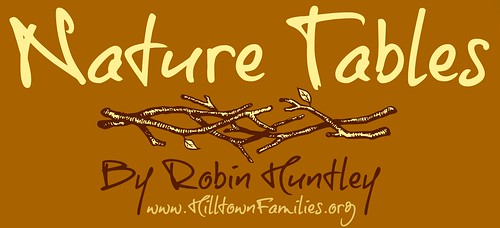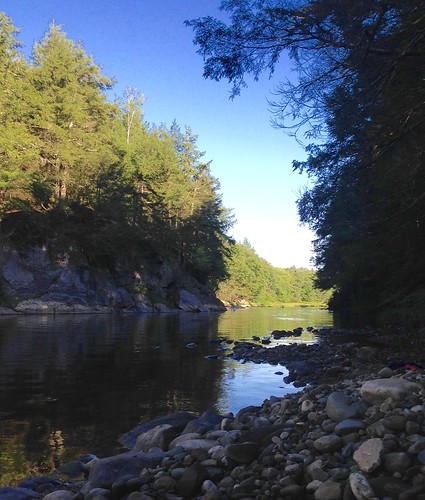Nature Table for August
Patterns, Perception & Preservation

This month’s nature table is written by environmental educator Phoebe Gelbard, a recent graduate of Northampton High School and a freshman at the University of Massachusetts.
This summer, whether you are swimming in a river, admiring a striking sunset, or smelling a flower, you can observe recurring shapes and patterns in the landscape around you. Change is a constant, and as each month fades into the next, previous patterns fade and new ones begin to appear. While we are all familiar with certain designs that are found in our backyards, such as the heart-shaped leaves of clover and the spiral of a snail’s shell, other patterns that involve multidimensional interconnectedness are more difficult to recognize. These patterns, known as fractals, are described as expanding or evolving symmetry because of the way that they repeat themselves when taking both a closer look and when stepping back.

Middle Gorge. Westfield River. [Photo credit: (c) Phoebe Gelbard]
Another accessible (and traversable) example of a fractal is a watershed. While cross-country trekking, we come across trickling, spring-fed rivulets that cascade into brooks and streams. These small tributaries feed the branches of rivers which then travel into the main flow of water that runs through a valley. Just as twigs make up limbs that connect to tree trunks, watersheds branch out into innumerable smaller variations of the original.
While developing an awareness of these patterns, one gains an understanding of their implications. Through walking the watersheds in which we live, we begin to realize that rivers are roads – complex systems of naturally-occurring infrastructure that are vital to the myriad of aquatic and reptilian species and the predators that rely on them.
While not all patterns contain fractal-like characteristics, there is often more than meets the eye when considering the bigger picture of each leaf and ripple. Observe the concentric rings indicating tree growth: how far apart is each ring from the next? What does this tell us about past growing conditions, both human-induced and naturally-occurring? In which ways do we alter the local landscape and the course of the global climate?
The next time you step outside, take a moment to look for the patterns that surround you while considering the larger pictures of which you are a part; the more mindful and conscientious we are of our surroundings, the more we are drawn to protecting them.
“‘Have you also learned that secret from the river; that there is no such thing as time?’ That the river is everywhere at the same time, at the source and at the mouth, at the waterfall, at the ferry, at the current, in the ocean and in the mountains, everywhere and that the present only exists for it, not the shadow of the past nor the shadow of the future.”
– Hermann Hesse, Siddhartha
A pattern-filled, fractal-centric nature table includes:
- – ferns, especially maidenhair
- – tree branches and/or roots
- – green tree leaves
- – watershed maps
- – evergreen or alder cones
- – moss, especially liverwort (try a picture rather than a sample)
Books to support the study of repeating patterns in nature include:
- Powers of Ten: About the Relative Size of Things in the Universe by Philip and Phylis Morrison
- Swirl by Swirl: Patterns in Nature by Joyce Sidman and Beth Krommes
- Mysterious Patterns: Finding Fractals in Nature by Sarah C. Campbell
- Wild Fibonacci: Nature’s Secret Code Revealed by Joy Hulme and Carol Schwartz
- Actual Size by Steve Jenkins
For further resources for exploring Fibonacci and other nature patterns, check out Fibonacci Sequence and Golden Ratio Drive Nature-Based Education.
Robin Morgan Huntley, Community-Based Education Correspondent
 A native to Maine, Robin joined Hilltown Families in early 2011. She is a graduate of Antioch University with a masters in education. Her interests within the field of education include policy and all types of nontraditional education. For her undergraduate project at Hampshire College, Robin researched the importance of connecting public schools with their surrounding communities, especially in rural areas. Robin lives and teaches 5th grade in the Hilltowns of Western MA and serves on the Mary Lyon Foundation Board of Directors.
A native to Maine, Robin joined Hilltown Families in early 2011. She is a graduate of Antioch University with a masters in education. Her interests within the field of education include policy and all types of nontraditional education. For her undergraduate project at Hampshire College, Robin researched the importance of connecting public schools with their surrounding communities, especially in rural areas. Robin lives and teaches 5th grade in the Hilltowns of Western MA and serves on the Mary Lyon Foundation Board of Directors.
 Hilltown Families
Hilltown Families 




























